기이 산지의 영지와 참배길
세계 유산
기이 반도의 험준한 산지 깊숙한 곳에 위치한 세 곳의 고유한 성지는 다음과 같습니다. 구마노 산잔, 고야산, 요시노&오미네.
이 성지들과 이들 사이를 연결하는 장엄한 참배길은 2004년 7월 7일 유네스코 세계문화유산에 등재되었으며 ‘기이 산지의 성지와 참배길’로 알려지게 되었습니다.
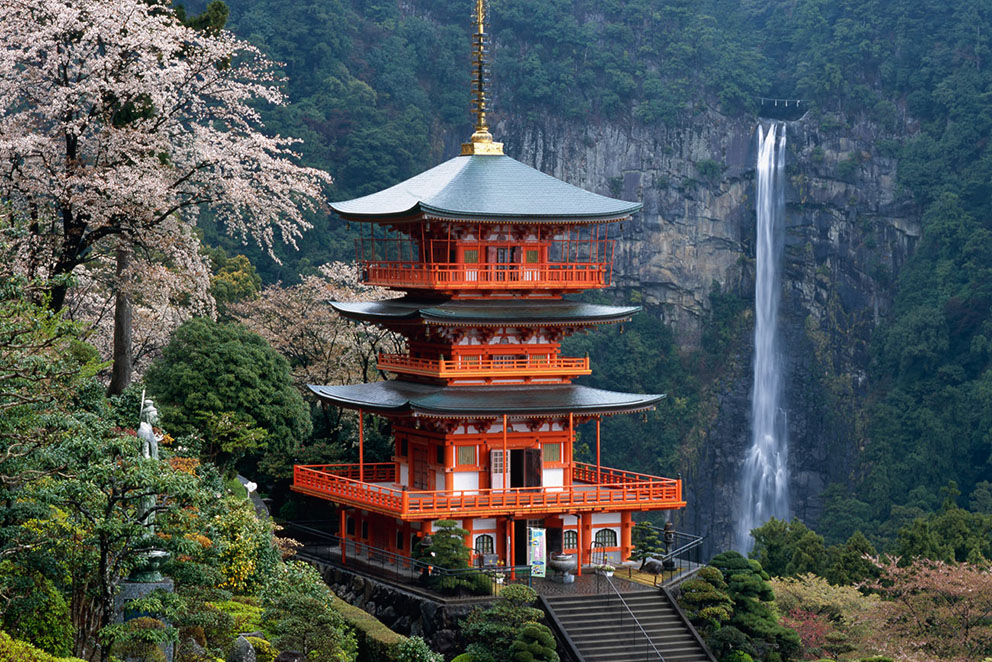
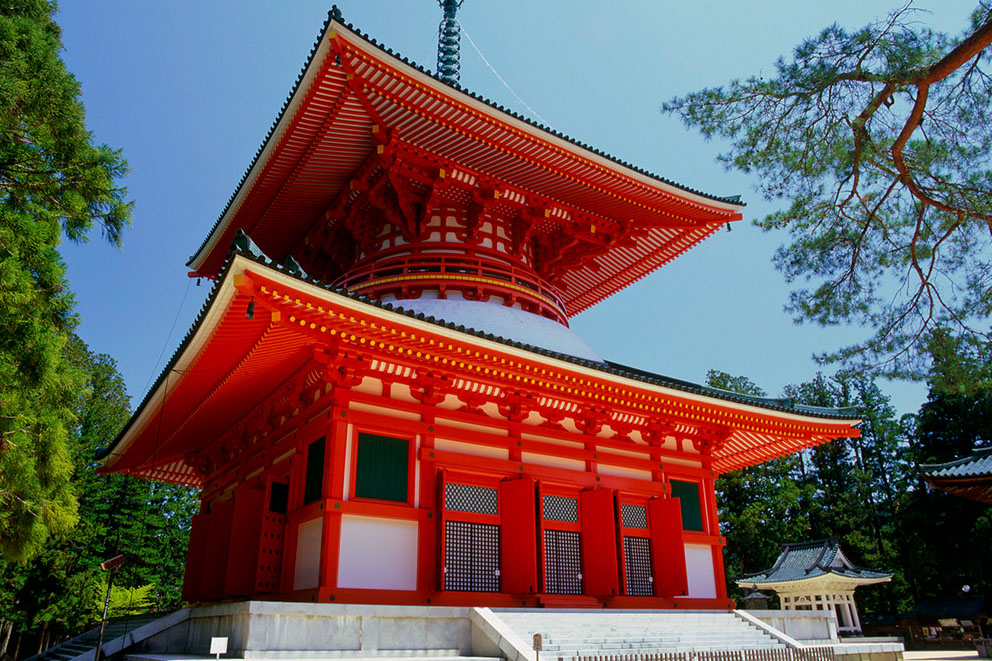
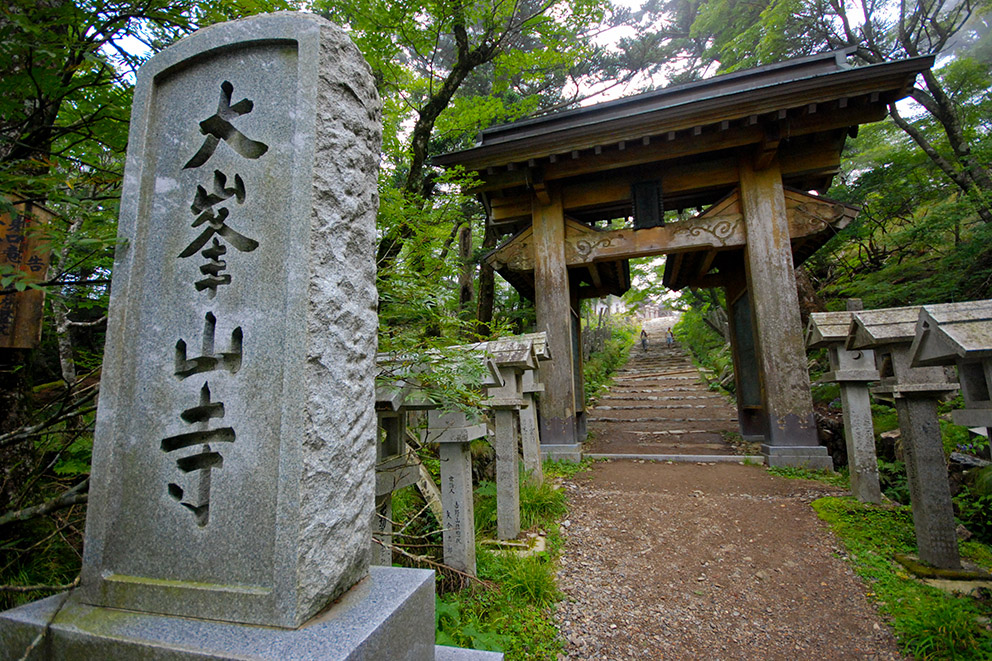
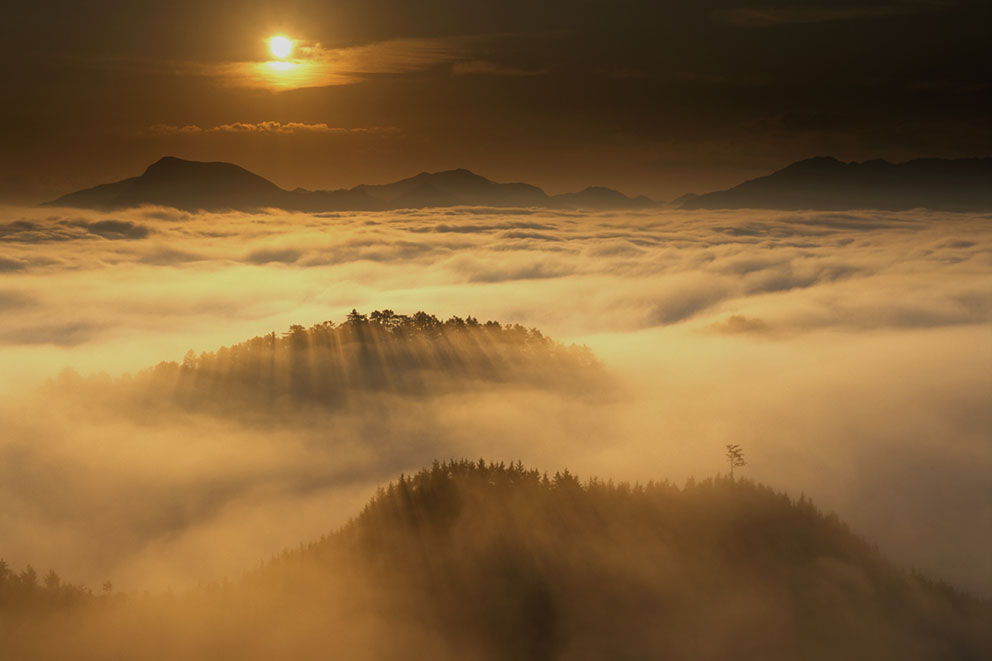
험준한 산, 들쑥날쑥한 해안선, 거대한 노목, 풍부한 폭포와 아름다운 강이 있는 이 광활한 자연 지역은 고대부터 숭배와 참배의 대상이 되어 왔습니다. 신들의 신성한 거주지로 여겨지는 이 지역은 신도 신사와 함께 성지가 되었습니다.
신사는 점차 중국과 한국에서 도입된 불교의 전통의 영향을 받으면서 독창적이고 혼합된 신앙 체계를 구축했습니다.
신사를 둘러싼 무성한 자연 환경에 의해 종교적 융합과 문화 발전이 이루어졌습니다. 수천 년의 역사를 지닌 기이 반도의 영적 전통은, 자연과 종교가 결합함으로써 강력한 신성함을 형성한 동시에 탁월하고 독특한 문화 경관을 구축했습니다.
- 와카야마 세계유산센터
- UNESCO 기이 산지의 영지와 참배길
구마노 산잔
구마노 산잔은 기이 산맥의 남동부에 위치한 세 곳의 신사인 구마노 혼구 다이샤, 구마노 하야타마 다이샤, 구마노 나치 다이샤를 일컫는 용어입니다.
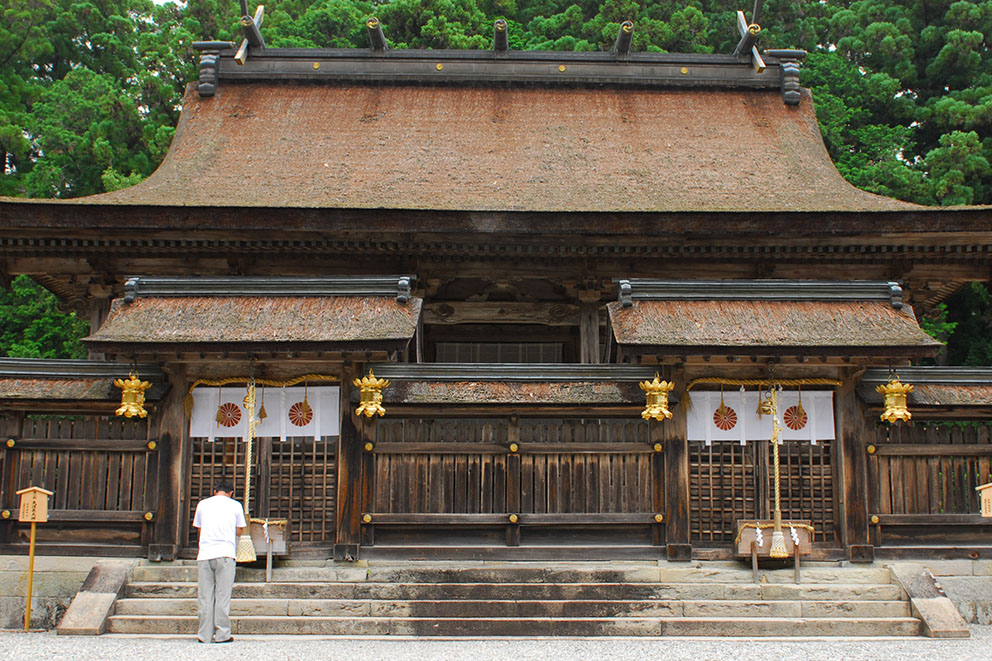
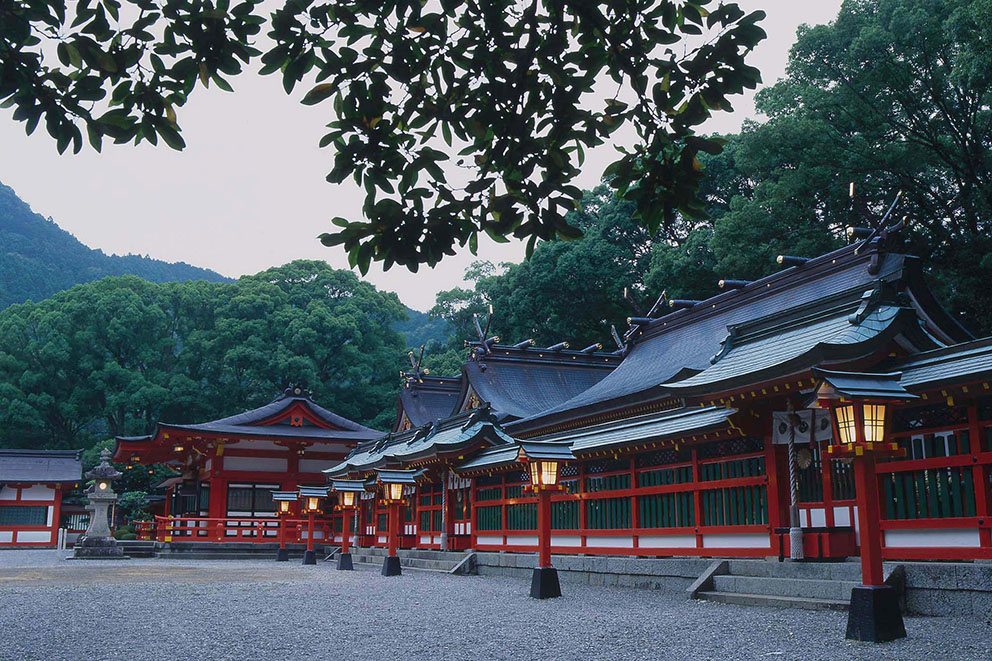
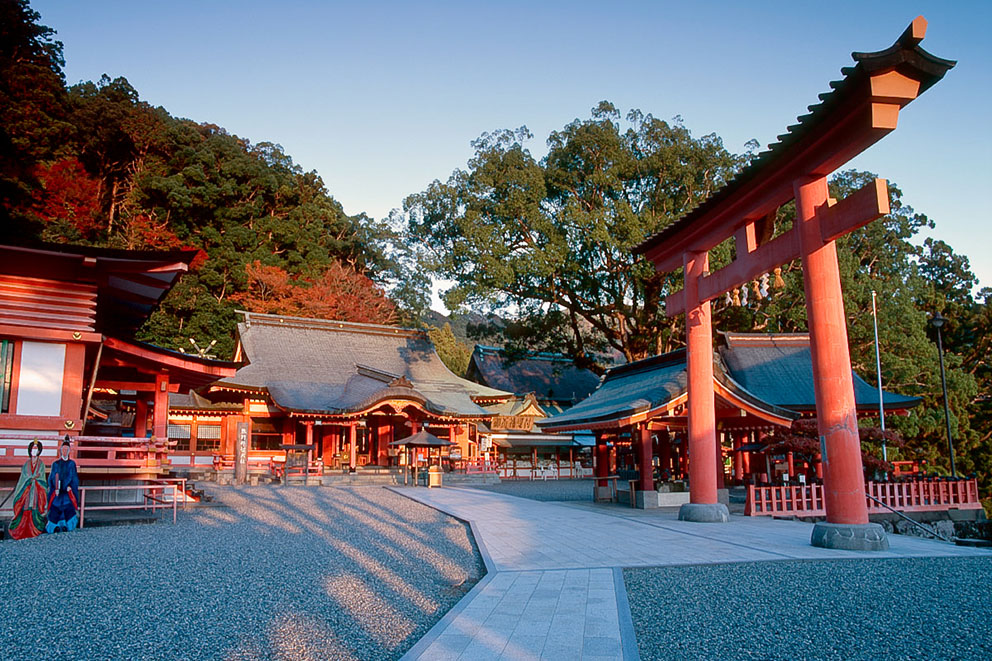
불교 사원 세이간토지와 후다라쿠산지 역시 이 성지와 밀접한 관련이 있습니다. 원래 이 세 곳의 대형 신사는 각각 고유한 자연 숭배 형식을 취하고 있었습니다. 10세기 후반에 이르러, 불교의 영향으로 세 수호신을 동시에 숭배하기 시작했습니다. 구마노 산잔의 삼신은 신도와 불교가 독특하게 혼합되었으며 일본에서 가장 강력한 것으로 여겨졌습니다.
11세기에 이 대형 신사는 황실과 귀족들의 참배지가 되었습니다. 15세기 후반까지 구마노 참배자의 대다수는 평민이었습니다. “개미들의 행진”이라 불릴 정도로 많은 사람들이 이곳을 찾았습니다. 선사 시대 이래로 현재까지 구마노 지역은 치유의 장소이자 신성하고 신비로운 신들의 거처로 여겨져 왔으며 이는 오늘날에도 마찬가지입니다.
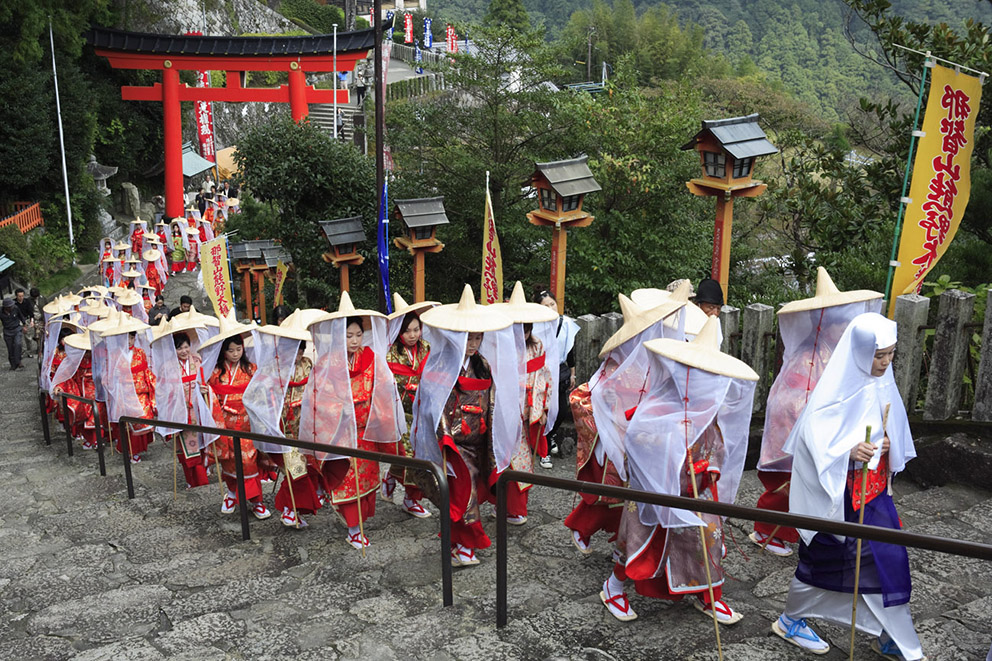
야타가라스
구마노 산잔에서 볼 수 있는 흥미로운 문양은 야타가라스(八咫烏: 세발 까마귀)입니다. 일본의 창조 신화에서 일본 초대 천황이 뚫을 수 없는 구마노 산맥을 주유하도록 도운 신의 사자이자 신비로운 안내자로 등장합니다.

세 다리의 해석
우주의 세 층
天= 천 = 하늘
‘地= 지 = 땅
人= 인 = 인간
구마노의 세 고대 가문.
宇井= 우이
鈴木= 스즈키
榎本= 에노모토
구마노 혼구 다이샤에서 그들은 또한 주요 신의 세 가지 미덕을 상징하기도 합니다.
智= 지 = 지혜, 큰 깨달음
仁= 인 = 인애, 인간에 가까운 신의 관점
勇= 용 = 용기, 새로운 접근으로 어려운 상황을 극복함
최종 휴게소
구마노 나치 다이샤의 성소에는 야타가라스가 진무 천황을 야마토로 안내하고 돌아온 후 돌로 변한 모습이라고 전해지는 큰 바위가 있습니다.
축구 성지
야타가라스의 보다 현대적인 활용은 일본 축구 협회의 로고에 있습니다. 두 다리로 땅을 단단하게 짚고 서 있으며 세 번째 다리의 발톱으로 축구공을 잡고 있습니다. 공으로 상대편 네트를 출렁이게 하도록 도와주는 강력한 길잡이!
나카무라 가쿠노스케(中村覚之助, 1878-1906)는 일본 축구의 창시자이며 가쓰우라에서 태어났습니다. 나카무라는 국가대표팀 엠블럼에 사용되는 현지의 야타가라스 심볼에 영향을 줬습니다. 1900년, 도쿄 고등 교육 학원(현 쓰쿠바 대학)에서 공부하면서 1902년에 일본에 축구가 도입되는 데 있어 기초가 된 “축구“라는 책을 번역했습니다. 같은 해 나카무라는 일본 최초의 축구팀을 창단했습니다.
UNESCO Documents
Brief Description
Set in the dense forests of the Kii Mountains overlooking the Pacific Ocean, three sacred sites – Yoshino and Omine, Kumano Sanzan, Koyasan – linked by pilgrimage routes to the ancient capital cities of Nara and Kyoto, reflect the fusion of Shinto, rooted in the ancient tradition of nature worship in Japan, and Buddhism, which was introduced from China and the Korean Peninsula. The sites (495.3 ha) and their surrounding forest landscape reflect a persistent and extraordinarily well-documented tradition of sacred mountains over 1,200 years. The area, with its abundance of streams, rivers and waterfalls, is still part of the living culture of Japan and is much visited for ritual purposes and hiking, with up to 15 million visitors annually. Each of the three sites contains shrines, some of which were founded as early as the 9th century.
Justification for Inscription
Criterion (ii): The monuments and sites that form the cultural landscape of the Kii Mountains are a unique fusion between Shintoism and Buddhism that illustrates the interchange and development of religious cultures in East Asia.
Criterion (iii): The Shinto shrines and Buddhist temples in the Kii Mountains, and their associated rituals, bear exceptional testimony to the development of Japan’s religious culture over more than a thousand years.
Criterion (iv): The Kii Mountains have become the setting for the creation of unique forms of shrine and temple buildings which have had a profound influence on the building of temples and shrines elsewhere in Japan.
Criterion (vi): Together, the sites and the forest landscape of the Kii Mountains reflect a persistent and extraordinarily well-documented tradition of sacred mountains over the past 1200 years.
Long Description
The Shinto shrines and Buddhist temples that form the cultural landscape of the Kii Mountains are a unique fusion between Shintoism and Buddhism illustrating the interchange and development of religious cultures in East Asia. They have become the setting for the creation of unique forms of shrine and temple buildings that have had a profound influence on the building of temples and shrines elsewhere in Japan.
The site consists of three sacred sites in the heavily forested Kii Mountains, a peninsula jutting into the Pacific, and a complex pattern of tracks and paths that link the sites together and to the ancient capitals of Nara and Kyoto to the north, which flourished from the 6th century to 1868. The steep, rugged mountains of the Kii Peninsula rise to 1,000-2,000 m and are heavily wooded. The natural beauty of the area, and its harsh but serene mountain environment, has probably been revered since prehistoric times. The three specific sites had become established as major sacred sites as early as the 11th or 12th centuries, attracting a great number of worshippers. The area is still part of the living culture of Japan and the sites are heavily visited and used for ritual purposes and for hiking. The pilgrim routes are not all contiguous as there are sections excluded where they have been influenced by modern development. The forested mountains underpin the significance of the whole site, for it is the beauty and drama of the mountains and their contrast with the seascape to the south which has attracted people for at least 2,000 years.
Each of the three shrines contains both buildings and objects, such as temples, shrines, statues and stupas, as well as revered natural elements such as trees, waterfalls, rocks, etc. The built structures are almost all of wood, constructed in a post and pillar construction similar to Japanese houses. Many have been successively rebuilt.
Yoshino and Omine: this is the northern-most site near to Nara. The Yoshino or northern part of the site was by the mid-10th century known as the most important sacred mountain in Japan and its reputation had reached China. It was the object of mountain worship, Shinto, in the 7th and 8th centuries and later in the 8th century became one of the prime sacred places for the Shugen sect of ascetic Buddhism. Omine, the southern part, was also associated with the Shugen sect and, in particular, with ascetic practices connected to the harsh mountain environment. This site consists of groups of buildings in what is said to be a unique architectural style constructed as an embodiment of Shinto-Buddhist religious fusion.
Kumano Sanzan: This site is the furthest south. The shrine buildings are said to show outstanding wooden architectural styles that have no comparators. Within the site are three main shrines, and two temples, connected by a pilgrims’ route. They reflect Shinto and the Shugen sect of Shinto-Buddhism, and were also closely associated with the search for the pure Buddhist land in the southern sea
Koyasan: This site south of Nara is partly in an alpine basin at an altitude of 800 m and partly at the foot of the mountains. It is actively used for annual festivals and rituals dedicated to the deity of the land and the rites of the Buddhist Shingon sect.
Pilgrim routes: As the sacred sites became established and well visited in the 11th or 12th centuries, a series of pilgrim routes were developed linking the sites to Kyoto and to other places throughout Japan – some based on earlier tracks. The routes in the mountains were designed to be arduous and the journey over them part of the religious experience, rather than a means to an end. Most of the routes are no more than 1m wide and of earth; in a few places stone steps or stone pavements were constructed, such as the 34 km stretch of stone paving through the forest, part of the Kumano Sankeimichi route between Kumano Sanzen and Ise Jungu.
Source: UNESCO/CLT/WHC
Historical Description
From the 3rd to the 2nd century BC, when rice culture was introduced into Japan and settlements began to develop in the lowlands, the Shinto religion, in which natural features such as mountains, forests, rocks and trees were revered as gods, came to be embraced – perhaps as a link to ancient dwelling sites in the hills. The mountain gods were thought to control water, essential for rice growing in the plains, and gold ore, needed as towns developed. It was also believed that the god who guided the first Emperor to build Nara the first capital resided in the mountains. Thus the Shinto religion came to be influential not only in rural areas but also in the towns as they were formed.
The introduction of Buddhism in the mid-6th century coincided with the development by the government of a centralised system of laws, following examples in China and the Korean peninsula. The government adopted Buddhism as the guardian religion for the nation and in the mid 8th century temples were built in each province of Japan. At the same time the concept of the Pure Land associated with the Kii Mountains begun to gain ground and people started to undertake training in the mountains.
In the 8th century the capital was moved to Kyoto and in the following century the esoteric Buddhist sect Mikkyo was brought to Japan from China. This stressed the belief that mountains are places for training to attain awakening. Out of this developed the local Shingon sect and many new temples were constructed in the Kii Mountains. The rise of Mikkyo/Shingon coincided with the rise in power of aristocrats whose authority was based on land ownership. They embraced this new sect, as did the Emperor who hosted various religious rites in what were coming to be seen as the sacred Kii Mountains. The new sect also interacted with Shintoism, a fusion that had been in existence since the 8th century and from this interaction the uniquely Japanese Shinto-Buddhist religion emerged which was to be a powerful force until the 19th century.
The growth of pilgrims visiting sites in the Kii Mountains seems to have coincided with the rise of social unrest around the capital in the 9th to the 10th centuries. It was at this time that many of the pilgrim routes were laid out.
In the following two centuries, 11th and 12th, the distinctly Japanese flowering of Buddhist practices, and the buildings that were associated with these beliefs, were strengthened by the government’s decision to stop sending delegations to China. The consecration of the three main sites in the Kii Mountains were all progressed, and gained considerable support from people who were wanting escape from the worsening social conditions characterised by conflict between samurai. The Imperial family, aristocrats and samurai all became benefactors of new temples and land to support them, as a means of guaranteeing a better life in the hereafter and a retired Emperor made a first pilgrimage to Koyasan and Kumano Sanzan in the late 1tth century – stimulating others to follow in ever larger numbers. This prompted the development of hospices, the improvement of shrines and temples, the construction of Oji shrines along the main routes, and the funding by the Imperial family and aristocrats of people to manage the sites.
The Kii Mountain sites were thus established by the end of the 12th century as the main sacred mountain site in Japan, and attained a status which would persist to the present day.
At the end of the 12th century the government was moved to Kamkura -although the ruling family remained in Kyoto. From the 14th to the 16th century conflict between Imperial factions, the grip on power by the samurai and battles between feudal lords meant a weakening of Imperial and centralised authority, but at the same time the growth of a monetary economy and improved methods of production led to a new rich class. Pilgrimages were now extended to anyone who could afford the journey.
From the 17th until 1868 a powerful feudal government was established in Edo (later Tokyo) and much of the land associated with temples was absorbed by the government. Support however for the temples continued form the government and ordinary people. At the same time improved roads made travel easier and the number of pilgrims begun to increase, as did those wanting to travel as tourists.
In 1868 the Emperor took control from the feudal government and the Imperial capital was moved to Tokyo. The new government introduced measures to control religions in Japan, and issued the Shintoism and Buddhism Separation Decree in 1868. This prohibited activities related to the Shinto-Buddhist fusion and statues of Buddha were removed from shrines. However because of the strong support by society at large for the Kii Mountains and their shrines, many survived. Such was the outflow of cultural properties from Japan as a result of the law that in 1897 the government brought in the Ancient Shrines and Temples Preservation Law, strengthening it is 1929, and extending it in 1919 to include natural sites.
After World War II, with the revitalising of the economy, visitors once again returned to the Kii Mountains and still visit in large numbers.
Source: Advisory Body Evaluation
